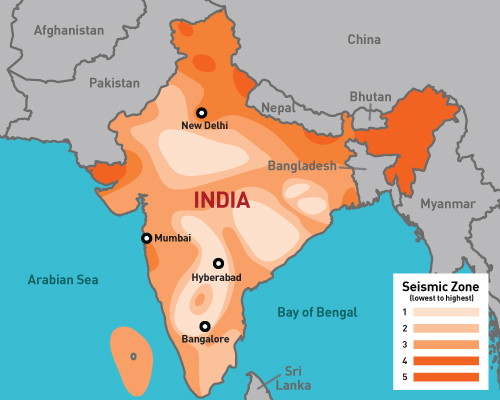India's Quake Hazard Called a Catastrophe Waiting to Happen
After the Dec. 26, 2004, Indian Ocean earthquake and tsunami that killed over 230,000 people in 14 countries, officials from the National Disaster Management Authority of India decided that installing deep-sea sensors could warn them of an impending disaster. The sensors, run by solar-powered panels, were installed in the Indian Ocean at great effort and cost.
Imagine their surprise then, when the NDMA received information a few weeks later that fishermen venturing out into the sea had not only stolen the sensors, but had sold them to make a bit of extra cash.
Over 58.6% of the land is prone to tremors. According to the NDMA, 68% of India's urban population is in danger due to poorly designed buildings vulnerable to earthquakes. An earthquake the size of the one to hit Japan in early 2011 could lay waste entire cities here, say seismic experts.
India is divided into five seismic zones. There are 344 towns in zone 5, which is the most seismically vulnerable. This renders them "amongst the most damage-prone cities in the planet," says Shashidhar Reddy, NDMA's vice-chairman. Dozens of other urban centers, including the capital, New Delhi, are in zone 4.
Illegal and poor quality constructions continue to thrive in the country because of corruption and a lack of enforcement of the rules.
In a recent survey conducted by the NDMA, it was revealed that most of the country's buildings were not built to resist earthquakes. Only 3% of buildings use concrete while 85 percent use brick and stone with no steel reinforcement. Of India's 822,000 engineers and architects, only 14,700 admitted to being trained in safe seismic engineering and from an estimated 3,200,000 masons, only 34,000 were found to have any knowledge of seismic design.
"There is a lot to be done," says R.S. Dattatrayam, the head of seismology at India's meteorological department under the Ministry of Earth Sciences. "We are addressing these issues from all angles."
One of the new projects the government has undertaken, he says, is to further classify megacities in high seismic zones into areas with higher or lower potential for damage, depending on soil characteristics.
That project is not enough, say others. "There are a few meek attempts by the government to try and look at disaster management, but I would actually put that down to completely non-effective systems," says Manit Rastogi, New Delhi-based co-founder of the architectural firm Morphogenesis. "They can't handle rain over a particular day [greater than] 100 mm, how are they going to handle an earthquake?"
Rastogi says there are two main problems in India. First, the majority of construction is outside the formal sector. In Delhi, for example, only about 15 to 20% of the population lives in buildings constructed to earthquake codes. "The bulk of the construction that takes place, whether it's unauthorized colonies or slums, is without professional or regulatory control," says Rastogi.





